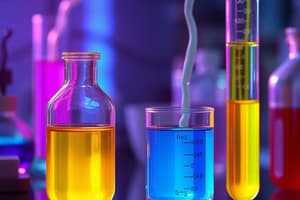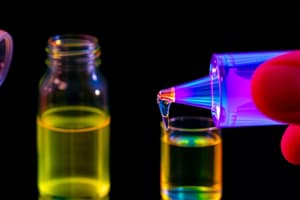Podcast
Questions and Answers
What should you do at the 2-minute mark during the absorbance measurement?
What should you do at the 2-minute mark during the absorbance measurement?
Stop the timer and turn off the lamp.
How often should the absorbance of Cuvette #3 be measured after the initial reading?
How often should the absorbance of Cuvette #3 be measured after the initial reading?
Every 2 minutes for a total of 14 minutes.
What is the purpose of using DCMU in Experiment II?
What is the purpose of using DCMU in Experiment II?
To investigate its effect as an inhibitor on the Hill reaction of photosynthesis.
How do you prepare a 1:10 dilution of DCMU from the stock solution?
How do you prepare a 1:10 dilution of DCMU from the stock solution?
What should be added to Tube #2 in the preparation phase?
What should be added to Tube #2 in the preparation phase?
Why is it important to vortex each test tube after adding the components?
Why is it important to vortex each test tube after adding the components?
What is the final step in handling the cuvettes after the experiment is completed?
What is the final step in handling the cuvettes after the experiment is completed?
Why were alcoholic beverages popular during the Middle Ages in Europe?
Why were alcoholic beverages popular during the Middle Ages in Europe?
What is the role of Saccharomyces in the production of both alcoholic beverages and bread?
What is the role of Saccharomyces in the production of both alcoholic beverages and bread?
What happens to the ethanol produced during the fermentation of bread?
What happens to the ethanol produced during the fermentation of bread?
What is the significance of carbohydrates in the ethanol production process?
What is the significance of carbohydrates in the ethanol production process?
What is required for carbohydrates other than glucose to be used in fermentation?
What is required for carbohydrates other than glucose to be used in fermentation?
Explain the chemical reaction for the fermentation process detailed in the content.
Explain the chemical reaction for the fermentation process detailed in the content.
How has the process of fermentation evolved in modern times?
How has the process of fermentation evolved in modern times?
Which plant materials are mentioned as substrates for fermentation?
Which plant materials are mentioned as substrates for fermentation?
What is the primary purpose of adding sodium carbonate at the end of the reaction?
What is the primary purpose of adding sodium carbonate at the end of the reaction?
How should absorbance values greater than 1.000 be reported?
How should absorbance values greater than 1.000 be reported?
What is the first step to prepare the reaction tubes before adding the enzyme?
What is the first step to prepare the reaction tubes before adding the enzyme?
Why is it important to stagger the addition of enzyme to the reaction tubes?
Why is it important to stagger the addition of enzyme to the reaction tubes?
What role does the blank tube play in this experiment?
What role does the blank tube play in this experiment?
What should be done if absorbance measurements fall below 0.000?
What should be done if absorbance measurements fall below 0.000?
Explain the importance of rinsing the cuvette between samples in this experiment.
Explain the importance of rinsing the cuvette between samples in this experiment.
What is the purpose of securely attaching the micropipette tip to the barrel?
What is the purpose of securely attaching the micropipette tip to the barrel?
Describe the function of the three positions of the control button on the micropipette.
Describe the function of the three positions of the control button on the micropipette.
What is the correct method to immerse the micropipette tip in a liquid during measurement?
What is the correct method to immerse the micropipette tip in a liquid during measurement?
Explain why the control button should be allowed to glide back slowly after immersing in the liquid.
Explain why the control button should be allowed to glide back slowly after immersing in the liquid.
What is the significance of 'blow-out' at Stop 2 when dispensing liquid?
What is the significance of 'blow-out' at Stop 2 when dispensing liquid?
What steps should be taken to safely eject the micropipette tip after use?
What steps should be taken to safely eject the micropipette tip after use?
Why is it important to avoid exceeding the maximum or minimum volumes with a micropipette?
Why is it important to avoid exceeding the maximum or minimum volumes with a micropipette?
What potential problem can affect experiments using a spectrophotometer, according to the content?
What potential problem can affect experiments using a spectrophotometer, according to the content?
What is the purpose of preparing serial dilutions of the enzyme stock solution?
What is the purpose of preparing serial dilutions of the enzyme stock solution?
How should the enzyme dilutions be labeled for the experiment?
How should the enzyme dilutions be labeled for the experiment?
Why is it important to stagger the time enzyme addition to each tube?
Why is it important to stagger the time enzyme addition to each tube?
What role does sodium carbonate play in the enzyme activity measurement?
What role does sodium carbonate play in the enzyme activity measurement?
What should be done with the cuvette before measuring the absorbance in the spectrophotometer?
What should be done with the cuvette before measuring the absorbance in the spectrophotometer?
How is the concentration of o-nitrophenolate produced determined from absorbance readings?
How is the concentration of o-nitrophenolate produced determined from absorbance readings?
What formula is used to calculate the reaction rate of o-nitrophenolate formation?
What formula is used to calculate the reaction rate of o-nitrophenolate formation?
What is the significance of using a blank solution when zeroing the spectrophotometer?
What is the significance of using a blank solution when zeroing the spectrophotometer?
What is the dilution factor for a solution made by combining 1.0 mL of stock solution with 9.0 mL of diluent?
What is the dilution factor for a solution made by combining 1.0 mL of stock solution with 9.0 mL of diluent?
Using the dilution formula, how would you express the concentration of a diluted sample (Cd) if the concentration of the undiluted sample (Cu) is 100 mg mL−1 and the dilution is 0.1?
Using the dilution formula, how would you express the concentration of a diluted sample (Cd) if the concentration of the undiluted sample (Cu) is 100 mg mL−1 and the dilution is 0.1?
In the formula V1C1 = V2C2, what does V1 represent?
In the formula V1C1 = V2C2, what does V1 represent?
If you want to prepare 200 µL of a 25 mg mL−1 solution from a 100 mg mL−1 stock solution, what volume of the stock solution (V1) do you need?
If you want to prepare 200 µL of a 25 mg mL−1 solution from a 100 mg mL−1 stock solution, what volume of the stock solution (V1) do you need?
What are the components of a microcosm that may be affected by fertilizer based on the objectives of the eutrophication experiment?
What are the components of a microcosm that may be affected by fertilizer based on the objectives of the eutrophication experiment?
What is the formula used to calculate dilution when determining the concentration of a diluted sample?
What is the formula used to calculate dilution when determining the concentration of a diluted sample?
What is the significance of conducting the eutrophication experiment in both terrestrial and aquatic environments?
What is the significance of conducting the eutrophication experiment in both terrestrial and aquatic environments?
How is the dilution factor calculated and what does it represent in a preparation?
How is the dilution factor calculated and what does it represent in a preparation?
Flashcards
Prepare 1:10 DCMU solution
Prepare 1:10 DCMU solution
Dilute DCMU stock solution 1:10 using RO water.
Prepare 1:100 DCMU solution
Prepare 1:100 DCMU solution
Dilute a 1:10 DCMU solution 1:10 using RO water.
Control Tube 1 (no DCMU)
Control Tube 1 (no DCMU)
Contains buffer, water, and DCPIP but no DCMU.
Cuvette Preparation (Steps 3-5)
Cuvette Preparation (Steps 3-5)
Signup and view all the flashcards
Hill Reaction Measurement
Hill Reaction Measurement
Signup and view all the flashcards
DCMU
DCMU
Signup and view all the flashcards
Absorbance Measurement
Absorbance Measurement
Signup and view all the flashcards
Cuvette #3 measurement
Cuvette #3 measurement
Signup and view all the flashcards
Ethanol fermentation
Ethanol fermentation
Signup and view all the flashcards
Simple carbohydrates
Simple carbohydrates
Signup and view all the flashcards
Complex carbohydrates
Complex carbohydrates
Signup and view all the flashcards
Structural carbohydrates
Structural carbohydrates
Signup and view all the flashcards
Yeast
Yeast
Signup and view all the flashcards
Fermentation byproducts
Fermentation byproducts
Signup and view all the flashcards
Glucose
Glucose
Signup and view all the flashcards
Ethanol Fuel
Ethanol Fuel
Signup and view all the flashcards
ONPG Solution
ONPG Solution
Signup and view all the flashcards
Phosphate Buffer
Phosphate Buffer
Signup and view all the flashcards
Enzyme Solution
Enzyme Solution
Signup and view all the flashcards
Blank Tube
Blank Tube
Signup and view all the flashcards
Reaction Rate
Reaction Rate
Signup and view all the flashcards
Spectrophotometer
Spectrophotometer
Signup and view all the flashcards
Inhibitor A
Inhibitor A
Signup and view all the flashcards
Sodium Carbonate
Sodium Carbonate
Signup and view all the flashcards
Micropipette Tip Attachment
Micropipette Tip Attachment
Signup and view all the flashcards
Micropipette Control Button Positions
Micropipette Control Button Positions
Signup and view all the flashcards
Micropipette Measurement Steps
Micropipette Measurement Steps
Signup and view all the flashcards
Micropipette Transfer Steps
Micropipette Transfer Steps
Signup and view all the flashcards
Micropipette Tip Disposal
Micropipette Tip Disposal
Signup and view all the flashcards
Micropipette Volume Units
Micropipette Volume Units
Signup and view all the flashcards
Micropipette Handling
Micropipette Handling
Signup and view all the flashcards
Spectrophotometer Precautions
Spectrophotometer Precautions
Signup and view all the flashcards
Serial Dilution
Serial Dilution
Signup and view all the flashcards
Enzyme Activity
Enzyme Activity
Signup and view all the flashcards
Why measure enzyme activity?
Why measure enzyme activity?
Signup and view all the flashcards
Standard Curve
Standard Curve
Signup and view all the flashcards
o-Nitrophenolate
o-Nitrophenolate
Signup and view all the flashcards
Aliquot
Aliquot
Signup and view all the flashcards
Dilution
Dilution
Signup and view all the flashcards
Dilution Factor
Dilution Factor
Signup and view all the flashcards
Concentration of Diluted Sample (Cd)
Concentration of Diluted Sample (Cd)
Signup and view all the flashcards
Concentration of Undiluted Sample (Cu)
Concentration of Undiluted Sample (Cu)
Signup and view all the flashcards
V1C1 = V2C2
V1C1 = V2C2
Signup and view all the flashcards
What is the formula for calculating the concentration of a diluted sample (Cd)?
What is the formula for calculating the concentration of a diluted sample (Cd)?
Signup and view all the flashcards
Calculating Dilution
Calculating Dilution
Signup and view all the flashcards
Preparing a Diluted Solution
Preparing a Diluted Solution
Signup and view all the flashcards
Study Notes
Photosynthesis
- Photosynthesis is the process by which green plants, algae, and certain bacteria convert light energy and CO2 into organic molecules.
- The overall process of photosynthesis can be summarized by the equation: 6 CO2 + 12 H2O → C6H12O6 + 6 O2 + 6 H2O.
- Photosynthesis involves two categories: light-dependent reactions and light-independent reactions (Calvin Cycle).
- In the light-dependent reactions, sunlight energy is trapped and converted to ATP and NADPH by an electron transport chain (ETC) and chemiosmosis.
- The products of light-dependent reactions are used to drive the Calvin Cycle, in which CO2 is reduced to carbohydrate.
- While the light-independent reactions don't directly require light, they are dependent on the products of light-dependent reactions.
- Light absorbed by photosynthetic pigments funnels energy to the reaction center chlorophyll a in Photosystems I (PSI) and II (PSII).
- Excited electrons are passed to the primary electron acceptor associated with the photosystem.
- PSII releases energy to transfer protons from the stroma to the thylakoid space.
- This generates an electrochemical gradient that powers ATP synthesis.
- PSII chlorophyll a in becomes a strong oxidizing agent that strips electrons from water to replace the ones lost.
- Light splitting (photolysis) splits H2O into protons and oxygen.
- Excited electrons in PSI are transferred to a separate ETC.
- The electrons are used to reduce NADP+ to NADPH.
- Electrons lost by PSI are replaced by electrons donated by plastocyanin.
The Hill Reaction
- In 1937, Robert Hill discovered that isolated chloroplasts produce oxygen when exposed to light and given an electron acceptor.
- The Hill reaction is formally defined as the reduction of any electron acceptor by electrons and protons from water, with the production of oxygen, when chloroplasts are exposed to light: H2O + A → AH2 + O2.
- Plant leaves are grinded then centrifuged to separate the chloroplasts from other cellular components.
- The isolated chloroplasts were suspended in cold sodium-potassium phosphate buffer (pH 7.3).
- A pigment DCPIP (oxidized blue) will act as a stronger oxidizing agent than NADP+, thus replacing NADP+ in the light-dependent reactions.
- DCPIP becomes colorless when reduced.
- The change in light absorbance at 620 nm can be measured, with the aid of a standard curve, to determine the DCPIP oxidized concentration over time.
Isolating Chloroplasts
- Collect a tube of chloroplast solution from the back bench. Wrap tube in aluminum foil and keep it on ice.
- This prevents the chloroplasts from overheating.
- Label 3 test tubes “1” through “3”.
- Wrap Tube #2 in aluminum foil.
- Place all 3 tubes in the test tube rack on your bench.
- Label 3 cuvettes “1” through “3”.
- Wrap Cuvette #2 in aluminum foil.
- Place all 3 cuvettes in a cuvette rack.
- Set up the light source and beaker of water.
- Ensure the spectrophotometer is on and set to 620 nm.
- Add 3 mL buffer and 1 mL RO water to Tube #1; do not add DCPIP (control).
Experiment II: Effect of Inhibitor on the Hill Reaction
- DCMU is a chemical used in many herbicides and an inhibitor of photosynthesis.
- A stock solution of DCMU is provided.
- Prepare a 1:10 and a 1:100 dilution of the inhibitor stock solution using RO water.
- Label 4 test tubes “1” through “4”.
- Add 2 mL buffer and 2 mL RO water to Tube #1 (control).
- Add 2 mL buffer, 1 mL DCPIP, and 1 mL of Stock DCMU to Tube #2.
- Add 2 mL buffer, 1 mL DCPIP, and 1 mL 1:10 DCMU to Tube #3
- Add 2 mL buffer, 1 mL DCPIP, and 1 mL 1:100 DCMU to Tube #4.
Additional Notes
- Specific steps and instructions to carry out the experiment are included.
- Different steps and experimental setups are described for different experiments and controls.
- Important aspects of proper setup, like the use of foil, are explained
- Data tables for recording results are provided.
Studying That Suits You
Use AI to generate personalized quizzes and flashcards to suit your learning preferences.
Related Documents
Description
This quiz explores the procedures and principles behind absorbance measurement along with key fermentation concepts. It covers important steps in experiments involving DCMU, as well as the role of yeast in alcohol production and baking. Test your knowledge of these scientific processes and their historical contexts.




